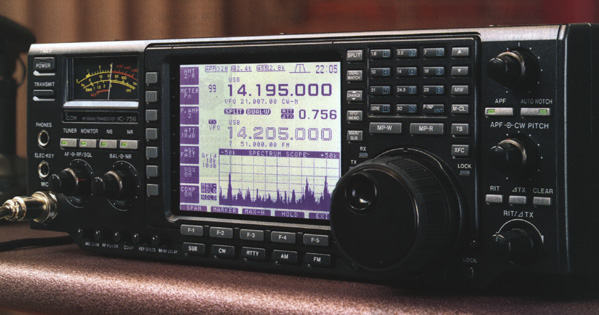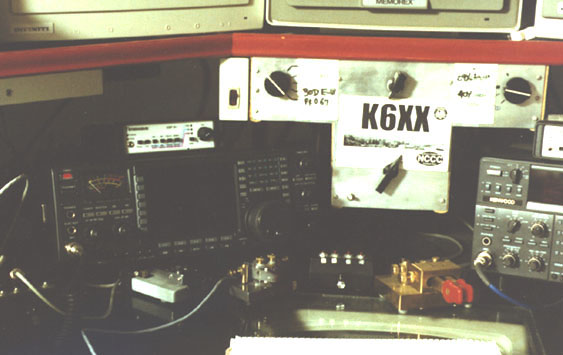
The IC-756 certainly looks impressive. Unfortunately, in this case, looks are deceiving.
Last Updated 31 May 1997

The IC-756 certainly looks impressive. Unfortunately, in this case, looks are deceiving.
10 March 1997. Updated 31 May 1997
Regarding the IC-756 MF/HF/6m rig from Icom--the one with the front panel LCD spectrum analyzer. After a short two weeks of playing, here are my opinions, which are undeniably worth every penny you spent on them.
The '756 is positioned differently in its domestic market (Japan) than it is upon export. In the United States, it is priced as a high-medium range rig; in Japan, it is a central-medium end radio. [And it is presently hundreds of dollars cheaper in Japan!]
1. Nice ergonomics; this is a good "two-handed" design--the controls are separated properly so your hands can operate it without fumbling over themselves.
2. Dual SO-239 connectors plus a separate receive-only antenna jack, and the configuration(s) may be memorized by-band.
3. Big, clean, clear display.
4. Transmit ALC works well, even with "fussy" amplifiers.
5. Tuner matching range is better than its specifications.
1. The sales literature (in Japanese, at least) boasts a 105 dB receiver dynamic range. Yet, AM broadcast band interference destroyed 160m reception until a DuneStar bandpass filter was inserted.
2. Noise blanker threshold is non-adjustable.
3. DSP is not in the AGC loop.
4. CW keying is choppy (see the note, below).
5. Printed schematic has errors (for example, where is the transmit control voltage generated?).
1. Noise blanker threshold adjustment
2. CW Keying improvement (see the note, below)
3. A higher voltage T/R relay, or an output voltage that corresponds with the transmitter timing, for driving an external transistor switch.
4. Microphone Compression metering option
5. CW sidetone monitor should have a menu option that allows either (A) sidetone always active (default), or (B) sidetone controlled by the MON switch (for dual rig contesting use).
6. The monitor output is too low, even at maximum, for useful compression/mic gain adjustment.
The antenna tuner is active in receive mode. This adds some selectivity (but not enough to solve the AM broadcast blast-through on 160m described earlier). And this idiosyncrasy can be confusing; I spent a few minutes debugging a dead receiver on 40m after operating on 6m--the antenna tuner was ON and still tuned to 50MHz, severely attenuating 7MHz signals.
CW keyed elements are shortened, making the keying "choppy". In "Semi-Break-in" mode, each keyed element is shortened by 5ms. A 0.33µF capacitor across the rear panel key jack fixes it. For QSK, the error is about 10ms (keying sounds terrible above 25WPM), and 0.68µF is needed. These fixes correct the timing for an external keyer or computer logging/keying system, but do not help the internal keyer's timing.
FM modulation is controlled by the MIC GAIN control on the front panel. With it fully counterclockwise, full power is transmitted, but no modulation. It does not seem to over-deviate with the GAIN fully clockwise, however. On my unit, the PL tone is excessively loud. The supplied operator's manual does not specify which internal control adjusts PL amplitude, and the service manual is not yet available.
I have just completed an interface box that includes a band output port and a CI-V to computer serial interface. The band output port drives things like relay-switched DuneStar band filters (Model 600, for example), remote coax switches, etc., and does not require a computer. The CI-V interface allows rig control via computer, and makes programs like CT and TR Log really shine.
The component cost of the full interface is relatively low: well under $20 at Digikey prices. I had all the parts in my junk box. You can probably build it for between $0 and $10 (but then, there is that $25 minimum order problem)
If you are interested, the design is on this web site at K6XX's Band & CI-V Interface for Icom Rigs

To: cq-contest@contesting.com (CQ CONTEST)
Date: Thu, 13 Mar 97 10:00:24 GMT
Subject: IC-756 Tests
Received from the Contest Reflector 13 March 1997
K6AW and W6OTC were nice enough to lend me an IC-756 to run some lab tests on.
K6AW has covered the operator impressions and features very well in a prior
note, so my intent here is to provide some performance numbers. Where
possible, performance numbers of an IC-765 have been included. You may note
that some performance numbers usually given are absent. This is due to the
lack of certain types of test equipment such as a spectrum analyzer in my home
lab.
Conditions: stock SSB filters, CW-optional 500 Hz@9 MHz and stock SSB@455 IF.
(Numbers in parentheses are for a reference IC-765 S/N 4616)
SENSITIVITY- SSB Noise Floor = -130 dBm, Preamp OFF (-128)
= -135 dBm, Preamp 1 IN (-134)
= -137 dBm, Preamp 2 IN
CW Noise Floor = -134 dBm, Preamp OFF (-133)
= -139 dBm, Preamp 1 IN (-140)
= -141 dBm, Preamp 2 IN
SELECTIVITY- Small signal, AGC off, SSB = 1900 Hz @ -3 dB (1020 Hz)
" " CW = 480 Hz (330 Hz)
Large signal, AGC on, SSB = 2570 Hz (2260 Hz)
" " CW = 1070 Hz (680 Hz)
BLOCKING- Noise limited for both radios within a few kHz of the desired
signal and not enough generator output to measure at 500 kHz
offset. Both radios are quite good.
Additional conditions: The third order, blocking and reciprocal mixing
tests were performed with a home brewed two tone generator using low noise
FET crystal oscillators.
THIRD ORDER PRODUCTS-
Tone spacing = 100 kHz;
Intermod products at the noise floor for two -32.5 dBm tones. (-29.5)
Third order intercept = +18.2 dBm (+22.7)
Dynamic range = 101.5 dB (103.5)
AGC - Extremely flat from minimum to maximum signal .
Rise = 1 - 3 ms, Fast to Slow. (3 ms.)
Undershoot = 20%, all speeds. (none)
Overshoot = 20%, all speeds. Small signal to large.(7% Fast, 17% Slow)
Recovery = 100 ms Fast, 400 ms Med, 1.4 sec Slow (30ms Fast, 0.6s Slow)
RECIPROCAL MIXING -phase noise
Measured with the radio offset from a crystal oscillator by the amount
indicated and adjusting the input level to raise the noise floor 3 dB.
Offset IC-756 IC-765
3 kHz -56 dBm, S9+16 -44 dBm, S9+38
5 kHz -48 -37
10 kHz -39 -30
15 kHz -34 -26
20 kHz -31 -23
50 kHz -22, S9+52 -16, S9+65
S meter readings above are for the indicated tone level on the respective
radios.
POWER OUTPUT-power supply set to 13.8 VDC
Band Tuner off Tuner on
1.8 MHz 98 watts 90 watts
3.5 100 93
7.0 101 95
10 102 95
14 102 93
18 103 95
21 104 92
24 103 91
28 103 87
50 85 77
KEYING - tested at 40 meters, no frequency effects noted.
Rise time = 0.7 ms for the first dot and 1.0 ms thereafter
Fall time = 3 ms down to approximately 3% , then drops rapidly to zero.
Delay to RF out, full break in = 6 ms to a 3% pedestal, 16 ms to start of
rise.
Delay to RF out, semi break in = first dot as above, then 6 ms to a 3%
pedestal, 10 ms to start of rise.
Note: the pedestal level stays constant as the power output is reduced.
Key up to RF off = 0, starts fall time immediately.
There is a pronounced dip or undershoot in power output approximately 75 ms
after key down to about 60% of full power at 100 watts and substantially
lower for lower power outputs. The good news is, it is virtually
unnoticeable over the air.
The keying is shortened as the delay to the rise and from the fall are not
the same. It is quite noticeably light. At 40 wpm the duty cycle of dots
is 40%. The so called "weight control" for the built in keyer only adjusts
dash length, not both dots and dashes as it should. The side tone is a true
representation of the key down periods. There are some key clicks in the
side tone (not terrible) which are more noticeable during full break in
operation.
SPEECH PROCESSING--average power increase due to processing.
Peak power output is 100 watts. White random noise is put into the mike
input and the level is adjusted for an ALC reading according to the
instruction manual.
Average power output, no processing = 17 watts (17 watts)
Average power output, with processing = 23 watts (42 watts)
Average power increase = 1.3 dB (3.9 dB)
1. Sensitivity is excellent and compares to the best radios.
2. Selectivity is good if cascaded filters are used.
3. AGC performance is excellent.
4. Dynamic range is very good.
1. Phase noise performance is not as good as it could be.
2. CW keying needs improvement. Side tone clicks should be eliminated.
3. The audio compressor is not adequate for competition.
4. The AGC is too flat. A few dB of tilt helps when picking signals out of
a pile up.George Cutsogeorge, W2VJN@rosenet.net
Umpqua, Oregon
http://www.qth.com/topten